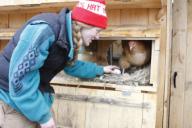Apr 8 2009
With 130 feet square feet of living space it's not palatial, but you can't beat the price. The entire building cost roughly $2000 to construct, about $15 per square foot. And the views of surrounding farmland are terrific!
 Courtney Perry of Concord, N.H., a student volunteer at Green Mountain College's Cerridwen Farm, gathers eggs at the College's new chicken house. The structure is the first project in GMC's new REED (Renewable Energy and EcoDesign) certificate program, open to students in any major
Courtney Perry of Concord, N.H., a student volunteer at Green Mountain College's Cerridwen Farm, gathers eggs at the College's new chicken house. The structure is the first project in GMC's new REED (Renewable Energy and EcoDesign) certificate program, open to students in any major
The house was just completed by faculty, staff and students at Green Mountain College, a four-year liberal arts school that emphasizes environmental sustainability throughout its curriculum. And it's just the right size for the current inhabitants, 70 six-week old chicks.
"It's constructed mostly from local materials," said assistant professor of environmental studies Lucas Brown of the new structure. "The lumber comes from white pine that was milled in town and the foundation and floor is made of slate supplied by a local quarry." The only concessions to non-local building materials are the roofing fasteners and hardware.
The chicken house was built off the side of a solar greenhouse on the College's Cerridwen Farm and represents a collaborative effort between Brown's ecological design class and the student farm crew working under the direction of farm manager Ken Mulder. "This is a good example of a GMC project that involves multiple disciplines," said Mulder. "Students learn about eco design and how to creatively use local materials. The chicken house contributes to our overall efforts at the farm: avoiding fossil fuels and practicing sustainable agriculture."
The chicken house and greenhouse are designed as an integrated system: excess carbon dioxide from the chicken coop will supplement CO2 in the greenhouse. While Mulder says the gas exchange probably won't extend the indoor growing season, it may boost the temperature inside the greenhouse in early spring when hours of daylight are limited, resulting in faster growing plants. Future plans include collecting rainwater from roof runoff to be used for watering livestock and plant irrigation.
Brown thinks the house is a good model for the College's REED (Renewable Energy and EcoDesign) certificate program, open to GMC undergraduates in any academic major. "Excessive energy use and consumption of resources are prompting builders and architects to reexamine the whole built environment," said Brown. "This program is designed to help students explore the renewable energy and green building fields within an already rich interdisciplinary education."
REED certification requires enrollment in a 22-credit program students can complete along with their major program of study within four years. A big part of the program is an external three-credit practicum where students get hands-on training in building and energy systems. Students will choose from a number of programs including two cutting edge practitioners in the field of renewable energy and design/build. The Yestermorrow Design/Build School in Warren, Vt., provides hands-on experience integrating design and craft, bridging the gap between architect and builder. Solar Energy International (SEI) is a Colorado-based school that shows how renewable energy resources like the sun, wind, and water can be used for sustainable energy systems that are practical, reliable, cost efficient, and environmentally sound.
"What I loved about the project was students and faculty working together to solve little design problems along the way," Ally Kraushaar, one of the students in the Brown's class who participated in the wood framing and installing the slate floor of the structure. "It was a fantastic hands-on learning experience."